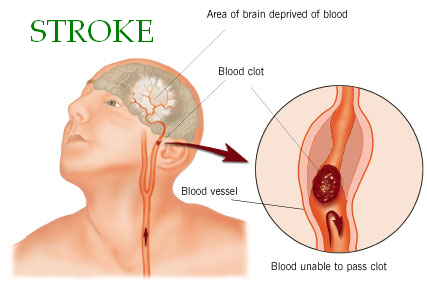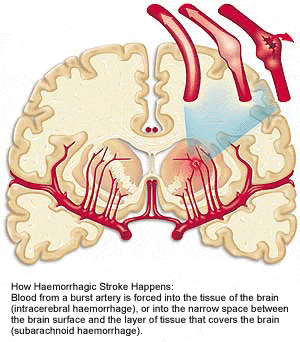Contents
- What is a Stroke?
- Two Types of stroke
- Transient Ischemic Attack (TIA)
- What Causes Strokes to Occur?
- Risk Factors
- It’s Important
- Management of Stroke
What is a Stroke?
A stroke (also known as a cerebrovascular accident or CVA) occurs when a part of the brain is not getting enough oxygen and nutrients to survive. Brain cells begin to die and symptoms occur according to the severity of the stroke and the part of the brain that has been affected.
Two Types of stroke
- There are two types of stroke. The most common is ‘ischemic stroke’ and accounts for about 80 percent of all strokes. This occurs when oxygen-rich blood flow to the brain is slowed down by fatty build-up (‘plaque’) resulting in narrowing of an artery (e.g. the internal carotid artery or the middle cerebral artery), or when an artery supplying blood to the brain is blocked by a blood clot or ‘embolism’.
- The other type of stroke is called ‘hemorrhagic stroke’ because it is caused by bleeding (hemorrhage) into or around the brain, which prevents the area of the brain, from getting the oxygen it needs.
Transient Ischemic Attack (TIA)
Most people receive no warning that they are going to have a stroke. However, a transient ischemic attack (TIA) may be a sign that an ischemic stroke is on its way. A TIA is caused a temporary interruption in the blood supply to part of the brain.
The symptoms of TIA are the same as for a stroke but they appear for a shorter period (several minutes to 24 hours). About one third of people who have had a TIA have a stroke within five years.
What Causes Strokes to Occur?
Ischemic Stroke
A build-up of fat and other materials on the side of an arterial wall is called a Thrombus.
A thrombus has its beginnings in an area of atherosclerosis that forms on the walls of an artery (i.e. the carotid artery or others). Atherosclerosis takes place when cholesterol-containing fatty deposits also known as plaques build up over time on the inside of the artery walls. Gradually, a growing thrombus causes the artery to narrow, reducing blood and oxygen supply to the brain, and increasing the risk of stroke.
Ischemic strokes can also occur when an embolism (a clot, or a small piece of plaque in one of the arteries leading to the brain or in the heart) is swept away through the blood stream to lodge in narrower brain arteries. The clot that forms an embolism is often created in the upper chambers of the heart (atrium) in people who have irregular heart rhythms (Atrial fibrillation).
Hemorrhagic Stroke
A hemorrhagic stroke can also occur when a blood vessel in the brain leaks or ruptures. This type of bleeding is called an ‘intracerebral hemorrhage’.Blood from the hemorrhage spills into the surrounding brain tissue and damages cells. In addition, brain cells beyond the leak or rupture do not receive oxygen-rich blood and also damaged. Uncontrolled high blood pressure is the most common cause of intracerebral (inside the brain) hemorrhage as it can cause the small arteries inside the brain to become brittle and easily cracked or ruptured.
Another type of hemorrhage causing hemorrhagic stroke is called ‘subarachnoid hemorrhage’. It is caused by bleeding that occurs between the surface of the brain and the skull. Aneurysms (ballooning of a weak spot in an artery wall) that have ruptured are the most common cause of this type of hemorrhage. After a subarachnoid hemorrhage, blood vessels may go into spasm ad constrict, preventing oxygen-rich blood from reaching brain cells in the area. Subarachnoid hemorrhage usually begins with a sudden headache that is worse than you have ever experienced before.
Risk Factors
High Blood pressure – high blood pressure increases the risk for both ischemic and hemorrhagic type stroke. It weakens and damages the blood vessels in and around brain, making them more likely to develop atherosclerosis, or rupture and hemorrhage. Regular blood pressure checks are of extreme importance in preventing stroke.
Blood Cholesterol – High levels of bad cholesterol (LDL) and triglycerides increase risk of atherosclerosis an ischemic stroke. Regular cholesterol checks, low-diet, physical activity and management of elevated LDL and triglycerides are important in the prevention of stroke.
Cigarette Smoking – Smokers have a much higher risk of stroke compared to non-smokers. Quitting is the best thing you can do for your health!
Overweight– Being overweight increases your risk of high blood pressure, heart disease, atherosclerosis and diabetes, all of which increase stroke risk. Talk with your doctor about a diet and exercise program if you are overweight.
Birth Control Pills – Stroke risk increases with the use of birth control pills, especially in women who are over the age of 35.
Additional risk factors for stroke, which you do not have control over, include family history, advancing age, gender (men have a higher risk than women before age 55) and race (African Americans are at greater risk).
It’s Important
If you have experienced a stroke, it is very important to get treatment as soon as possible. For treatment of an ischemic stroke, treatment with a clot-busting drug must take place within three hours. Following are the most common signs of stroke:
- Sudden numbness, weakness, or paralysis of the face, arm or leg (this usually occurs on one side of the body only)
- Loss of speech, or trouble talking or understanding speech
- Sudden blurred, double or decreased vision
- Dizziness, loss of balance or loss of coordination
- A sudden, severe headache or an unusual headache, which may be accompanied by a stiff neck, facial pain, pain between the eyes, vomiting or altered consciousness
- Confusion, or problems with memory, spatial orientation or perception
- Seizures, fainting or blacking out
Management of Stroke
If you have had a stroke the doctor will need to carefully assess the type of stroke it was. Ischemic stroke is treated with drugs designed to dissolve blood clots, while this type of medication could worsen the symptoms of hemorrhagic stroke.
Drugs used to help reduce risk of having TIA or another ischemic stroke include:
Antiplatelet Drugs (ASA, clopidogrel and ticlopidine) – ASA is used more often because of its low cost and similar effectiveness. Ticlopidine use requires that lab tests be done to monitor for infrequent harmful effects on blood cells.
Anticoagulants – Heparin works quickly to reduce the clotting ability of the blood and is usually used in the hospital. Warfarin is slower acting and is used over a longer term. It is very important that regular blood tests be done with this medication to ensure that the clotting ability of the blood is in the right range.
Hemorrhagic Stroke is most often treated by surgical procedures to repair the cause of bleeding.
Written by: Winter Rose
Copyright © by www.siyalla.com
[Earlier our website was www.ehealthut.com]


